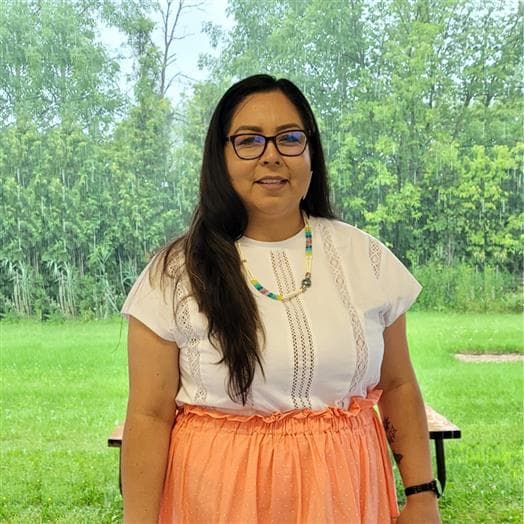Chenoa Plain, member of the Aamjiwnaang First Nation located in Sarnia, Ontario and descendant of the Ojibway and Navajo people, learned how to bead from her mom. “I started off on a loom when I was about 10 years old. Since then, I’ve grown into my own creativity. I love beads – all the different colours, shades, styles and cuts. I enjoy different projects: beaded medallions, lanyards, earrings, and sewing. I am most proud of my recent 3D design – a beaded pow wow grass dancer, with beaded fringes.”
For Chenoa, the design process can take a long time. “Typically, I sit down with pen and paper to sketch out the design. Sometimes it will come to me in a dream. Or, if I’m collaborating with someone, we discuss their vision. Different families, and different tribes have their own unique designs that they show in their beadwork. For example, florals may vary from tribe to tribe – some have more shapes and geometric while others may be more round and wispy. Then, once I know the design, I can choose the colours and types of beads that work best together.”
When creating her Petro-Canada logo, Chenoa took a considerable amount of time to arrive at a final design. “I prayed on it to help me decide what I should emphasize in this piece. I wanted to include elements that represent all the issues that we (Indigenous people) are going through. The handprints and spirit circles on the right side of the maple leaf represent all our Missing & Murdered as well as those who did not return from Residential schools.”
Chenoa also included elements from her own heritage. “The Ojibway florals with the roots on the left of the maple leaf represent Anishinaabe people as well as the growing that we all do every day. The inner maple leaf houses a portion of my First Nation logo – the opening of a tipi – representing the relationship that First Nations have with companies like Petro-Canada as they move towards Truth and Reconciliation with our people.”
Chenoa continues, “Finally, the lip of the circle above the maple leaf represents the sun and the moon, recognizing the importance of Creation.” She pauses. “I don’t want to forget all that is happening in today’s world. But overall, I think this is a hopeful piece.”
Chenoa was happy to participate in our beaded logo project. “It’s important to have First Nations representation in today's society. I see it as Indigenizing Colonized spaces.” Chenoa thinks projects like this can be good for reconciliation but cautions against a “one-size-fits-all” approach. “Reconciliation means that we all continue to work together in a positive way. While it is important to acknowledge our shared history, it is equally important to understand that each Indigenous person is affected differently. I know that change can take time – it’s a process. Every step helps as long as it is in a positive direction.”





